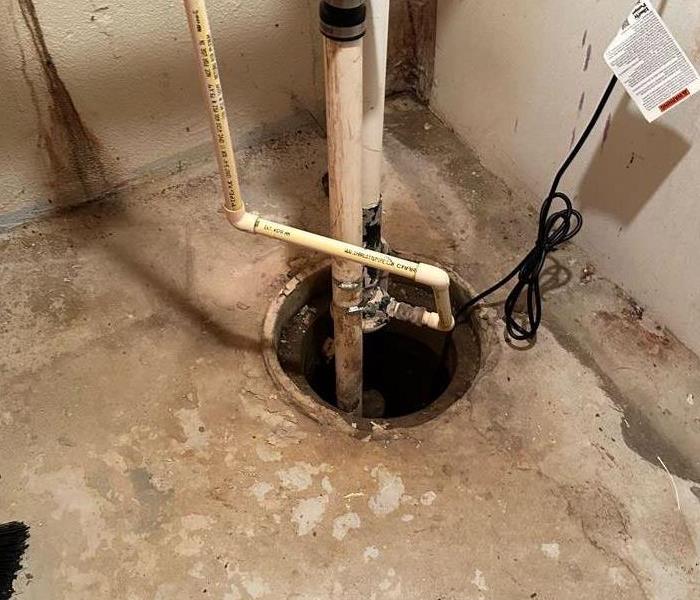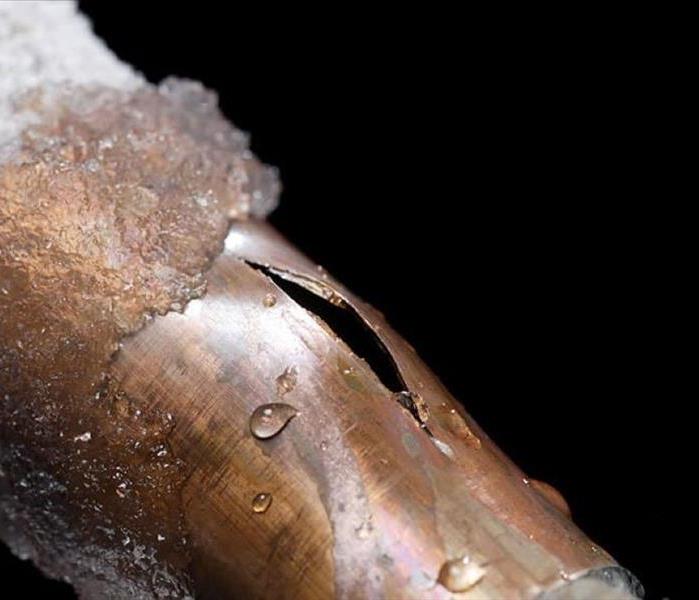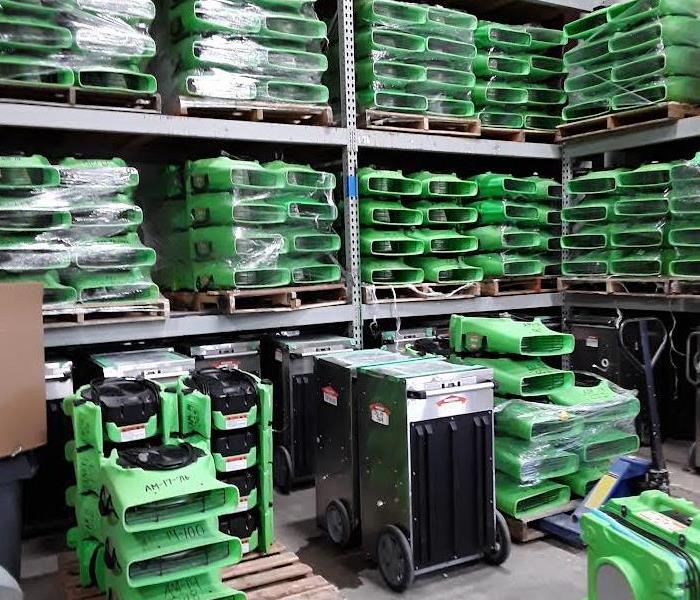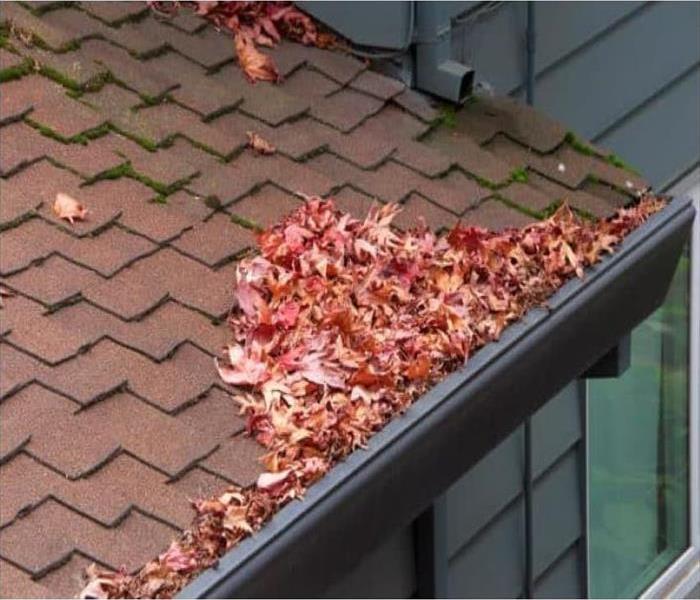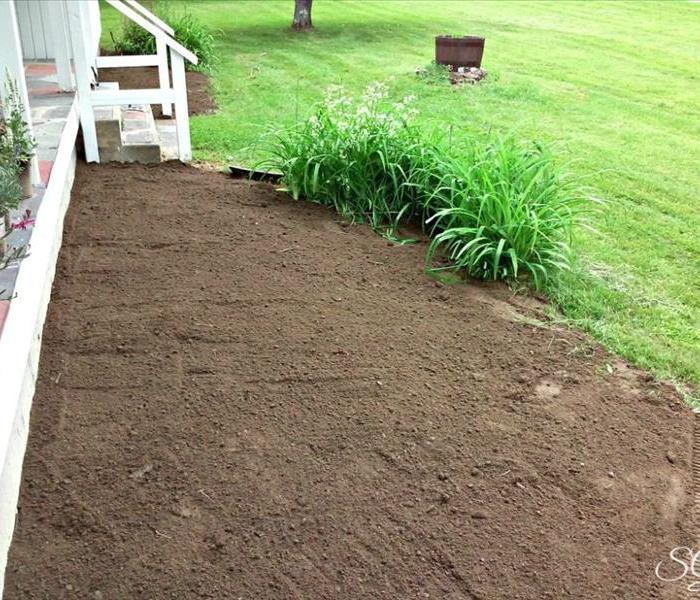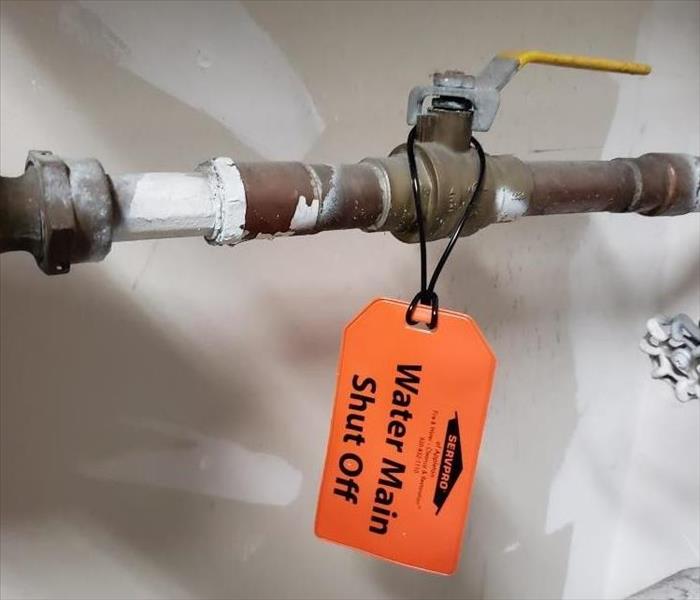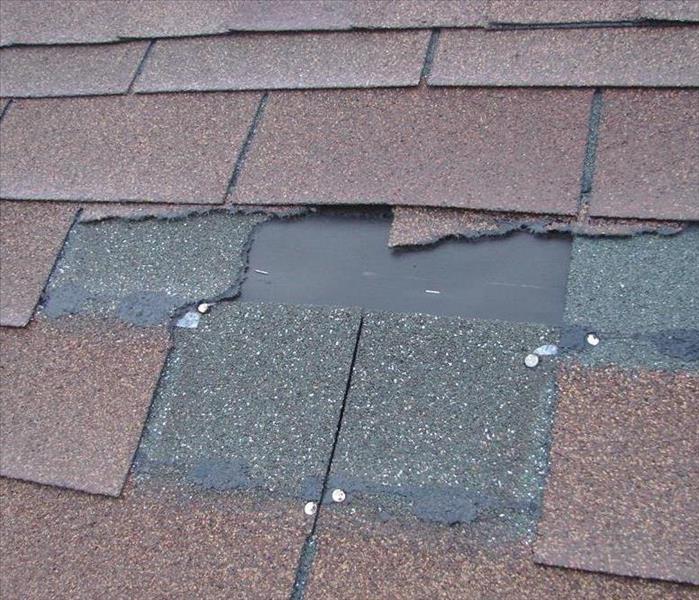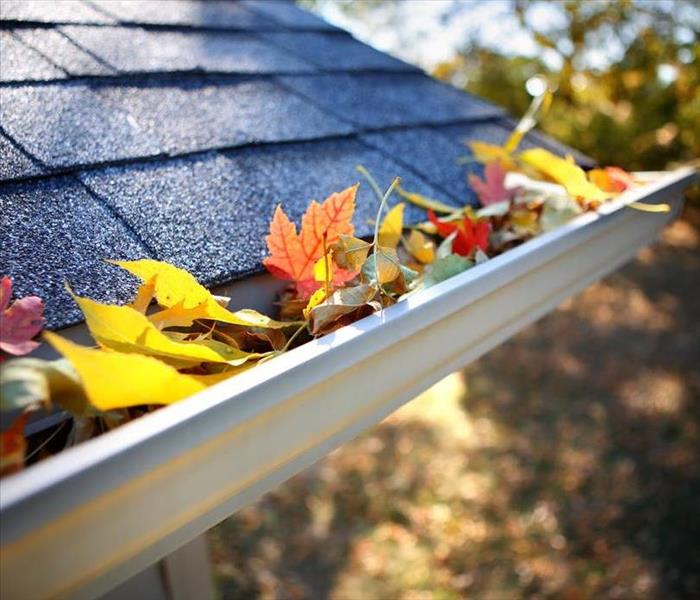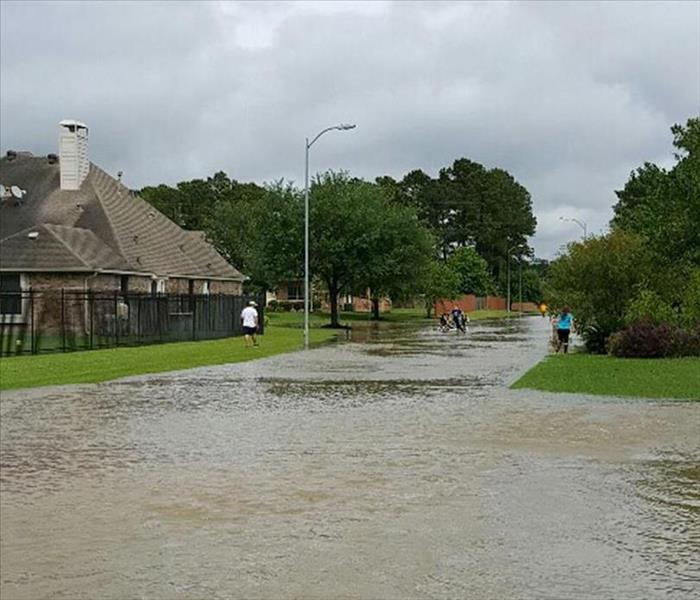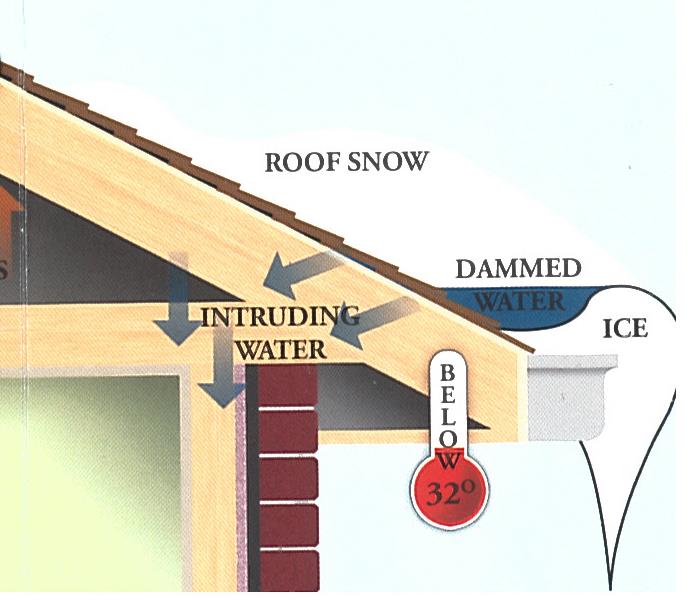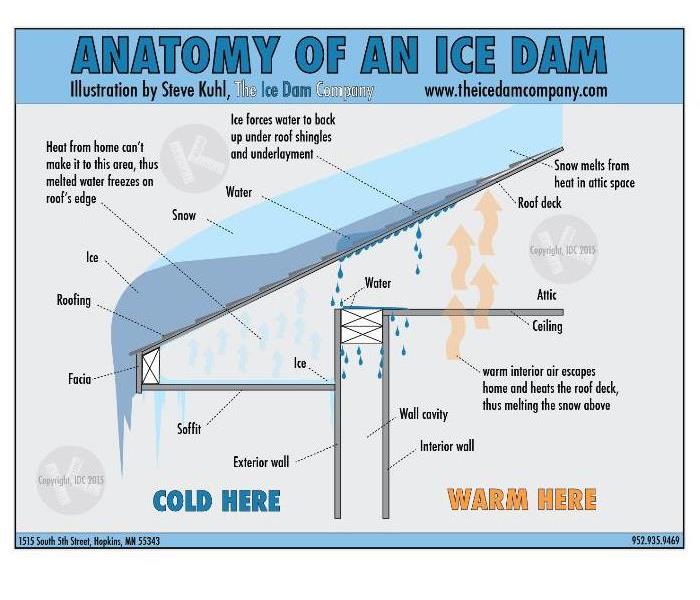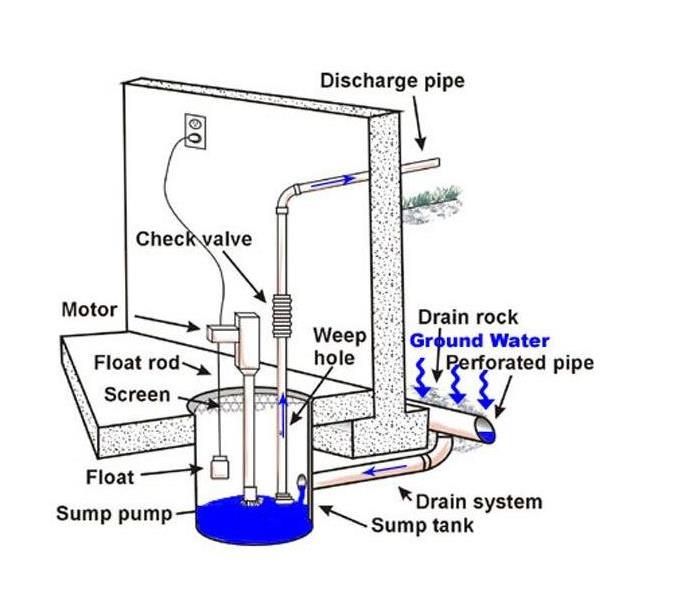Recent Water Damage Posts
5 Common Causes of Home Water Damage and How to Prevent Them
11/6/2024 (Permalink)
Water damage can wreak havoc on your home, leading to costly repairs and long-term issues. Here are five common causes of water damage and tips on how to prevent them:
Leaky Roofs
Damaged or missing shingles can allow water to seep in during storms. Regularly inspect and repair your roof to prevent leaks.
Burst Pipes
Cold temperatures can cause pipes to freeze and burst. Insulate pipes and keep your home’s temperature consistent during winter months.
Faulty Appliances
Old or malfunctioning appliances like washing machines or dishwashers can cause major water damage. Regular maintenance and timely replacements can help avoid leaks.
Clogged Gutters
Gutters filled with debris can overflow, leading to water damage around your home’s foundation. Clean your gutters regularly, especially after heavy storms.
Poor Drainage Systems
Improper drainage can cause water to pool around your foundation, leading to leaks or flooding. Ensure your property’s drainage system is working efficiently.
While prevention is key, water damage can still happen unexpectedly. If the worst occurs, call SERVPRO for fast, professional water damage restoration. Our team is available 24/7 to help you get your home back to normal quickly and effectively.
Winter Prep: Preventing Burst Pipes and Water Damage
9/18/2024 (Permalink)
Winter’s cold temperatures can lead to frozen pipes, which may burst and cause extensive water damage. To avoid this costly problem, here are a few steps you can take to protect your home:
Insulate pipes in unheated areas like basements, attics, and garages. Pipe insulation helps prevent freezing, especially in exposed spaces.
Seal drafts around windows, doors, and any gaps near pipes. This keeps cold air out and reduces the risk of frozen pipes.
Maintain consistent heating throughout your home, even when you're away, to ensure pipes stay warm enough to prevent freezing.
If a pipe does burst, SERVPRO offers 24/7 water damage restoration, using advanced drying equipment and expert repairs to restore your home quickly. Be prepared this winter, and rely on SERVPRO for help when it’s needed most.
How to Test Your Sump Pump and Why You Need a Sewer Sump Pump Rider
9/1/2023 (Permalink)
A sump pump is a vital component of your home's drainage system, especially if you live in an area prone to heavy rain or flooding. Its primary purpose is to prevent water from accumulating in your basement or crawl space, which can lead to costly water damage and mold growth. To ensure your sump pump is in good working condition and your home is protected, regular testing is essential. In this blog post, we'll guide you through the steps of testing your sump pump and explain why having a sewer sump pump rider on your homeowner's insurance policy is crucial in case of failure.
Testing Your Sump Pump
- Locate Your Sump Pump: Before you can test your sump pump, you need to know where it's located. Most sump pumps are found in the basement, typically in a sump pit.
- Ensure Power Supply: Make sure the sump pump is plugged in and receiving power. It's recommended to have a backup power source, such as a battery or generator, in case of a power outage during heavy storms.
- Inspect the Discharge Pipe: Ensure the discharge pipe is connected correctly and directs water away from your home's foundation.
- Check the Float Switch: The float switch is what triggers the sump pump to turn on when the water level rises. Pour a bucket of water into the sump pit and watch to see if the float switch activates the pump. The pump should start automatically when the water level rises.
- Listen for Unusual Noises: When the sump pump is running, listen for any unusual noises, such as grinding or clunking sounds, which may indicate a problem.
- Test the Check Valve: The check valve prevents water from flowing back into the sump pit once it's pumped out. Make sure it's functioning correctly by observing the water flow.
- Regular Maintenance: Schedule routine maintenance for your sump pump. This includes cleaning debris from the pit, checking for rust or corrosion, and ensuring all parts are in good working order.
Why You Need a Sewer Sump Pump Rider
A sump pump can be a lifesaver when it comes to preventing water damage in your home, but what happens if it fails? Here's where a sewer sump pump rider on your homeowner's insurance policy comes into play:
- Coverage for Sump Pump Failure: Standard homeowner's insurance policies may not cover damage caused by sump pump failure. A sewer sump pump rider provides additional coverage specifically for this scenario, ensuring that you're financially protected.
- Peace of Mind: Knowing that you have coverage in case of a sump pump failure can provide peace of mind. You won't have to worry about the high costs of water damage restoration and repairs out of your own pocket.
- Immediate Action: If your sump pump does fail, it's crucial to act quickly to minimize damage. Having coverage means you can call professionals like SERVPRO to clean up and restore your home promptly.
Conclusion
Testing your sump pump regularly is a simple yet vital task to ensure it functions properly when you need it most. Additionally, having a sewer sump pump rider as part of your homeowner's insurance policy is a smart investment to protect your home and finances in case of a sump pump failure. Remember, it's better to be prepared and proactive than to deal with the consequences of water damage without proper coverage.
National Repeat Day
6/2/2022 (Permalink)
June 3rd is National Repeat Day. Having to call SERVPRO to help clean up after a disaster is not something most people want to repeat. So today might be a good day to assess your property and determine if there is anything you can do to prevent that from happening.
While we typically think about cleaning our gutters in the fall, ideally gutters should be cleaned twice a year. Spring and early summer is another great time to clean your gutters. Keeping your gutters clean will allow rainwater to flow through them and away from your home’s foundation, helping keep your basement dry.
It is also a great time to check the slope around your foundation to ensure that rainwater running across the surface of the ground, because of heavy rain or frozen ground, will flow away from your home and not into it. Following is an article to help you determine if you have the proper slope around your foundation. If not, summer is a great time to make those adjustments so that next winter when we have rain on frozen ground, you don’t find water flowing into your basement. If you’ve ever had that happen to you, we’re sure it’s not something you want to repeat, especially since that type of flooding is typically not covered under your homeowners insurance policy.
How Much Slope You Need Near a House in Land Grading (thespruce.com)
Winter Storms & Burst Water Pipes
12/14/2021 (Permalink)
Once again the Fox Valley is experiencing mild temperatures for this time of the year. But those of us who have lived in Wisconsin for any length of time know that winter storms and severe cold snaps are headed our way. Subzero temperatures, winter storms and even thawing periods create some of our busiest times of the year. The culprit, burst water pipes. Now is a good time to do a little preventative maintenance.
You might be asking yourself why thawing periods would be a problem. Without getting into the chemistry of water and what causes it, suffice it to say that water expands as it freezes. While this expansion can cause a weak pipe to burst, it's usually not the direct cause of a burst pipe. Pipes usually burst where little or no ice has formed. That's because the break is usually the result of increased pressure in the pipe and not expanding ice. Pipes burst when water thaws and begins to flow, but then runs into other, still-frozen parts of the pipe and builds up pressure.
What can you do to prevent burst pipes? The simple and most direct answer is to keep your water pipes warm and prevent them from freezing. Typically homes in Wisconsin are built with the water pipes located on the inside of the building insulation, which protects the pipes from subfreezing weather. That said, if your homes insulation is inadequate, you may have a problem. Also consider that any hole on an outside wall for things like television or cable wires, phone wires, or even furnace exhaust vents, can let cold air in. These openings need to be properly insulated as well. If you're building a new home, or doing a home remodel project, it's also a good idea to locate your plumbing pipes on inside walls versus outside walls whenever possible.
To further protect your water pipes, it's a good idea to insulate the pipes themselves. Most hardware stores or home improvement stores carry foam rubber or fiberglass sleeves that most homeowners can install themselves. Plumbing supply stores and insulation dealers carry pipe sleeves that feature extra-thick insulation, as much as one or two inches thick. These sleeves will obviously cost a little more but may be worth the extra cost.
One last thing to consider, even the best insulation in your home, and on your pipes, may not be enough to protect your pipes from freezing during particularly cold temperatures. If your furnace breaks down while you are out of town on vacation, you may return to a huge mess. If you plan to be out of town during the winter months, you may want to consider purchasing a remote temperature monitor, or a thermostat that allows you to monitor the temperature remotely. A remote temperature monitor is a digital thermometer that tracks ambient changes in temperature. The sensor then streams the temperature data using wireless technology such as Wi-Fi, Bluetooth or GSM to your computer, tablet or cell phone. This way you can be alerted to any problems at home, even when you're away, so that you can send someone to address the problem before it's too late. Remote temperature monitors are not terribly expensive. They can be purchased on-line or at hardware stores and home improvement stores for as little as $50 or less.
And as always, if one of your water pipes bursts and floods your home or business, the experts at SERVPRO of Appleton are here to help.
Water Damage Remediation Equipment
12/7/2021 (Permalink)
Air movers and dehumidifiers are the core of water damage remediation. They work in tandem to dry your property quickly and efficiently. While there is a scientific explanation to how air movers and dehumidifiers work together to dry, in very simplistic terms, air movers get air circulating and encourage water in flooring, drywall, furniture etc..to evaporate into the air. That can create a very humid environment, so much so that proper drying is hindered. That’s where the dehumidifiers come in. They remove the excess water from the air.
We use industry standard formulas to tell us how many air movers and dehumidifiers are needed for each water loss situation. You might be surprised just how many air movers and dehumidifiers it can take to properly dry your loss. But rest assured, no matter what the size of your loss is, we have the equipment to fit your needs. We have over 1,000 in our shop at any given time. Whether your water loss is contained to a corner of your kitchen from a leaky frig or spans thousands of square feet in a warehouse, we’ve got you covered.
Once we remove our equipment from you property, it is brought back to our shop, cleaned & sanitized, shrink wrapped onto pallets and stored for the next disaster.
Clogged Gutters
11/17/2021 (Permalink)
Fall color came a bit late this year. Many trees are still dropping leaves in the middle of November. So while you may be used to cleaning your gutters earlier in the season, you will want to get out there and make sure your gutters and ridge lines are free of leaves and other debris now before the snow flies in earnest. Keeping your gutters free of leaves and debris will keep rain and snow melt flowing through your gutters and away from your home. This preventative maintenance will help avert water damage to your home this winter. Clogged gutters can cause ice dams in the winter, and ice dams can result in water damage to your home.
An ice dam is a ridge of ice that forms at the edge of a roof and prevents melting snow (water) from draining off the roof. As snow melts from your roof, either by the heat of the sun, or by heat escaping from your home, it tends to refreeze at the edges and other juncture points of your roof. The refreezing of water has a damming effect creating an even bigger ice dam behind it. Continuous feeding of the ice dam by melting and refreezing snow melt can cause significant damage. As the water seeps under shingles, it refreezes expanding and creating an even bigger gap for future drainage to fill and further the cycle. Your shingles are being raised and eventually the water that backs up behind the dam, and underneath the shingles, can leak into your home and cause damage to walls, ceilings, insulation, and create a perfect environment for mold growth.
The forecast for the Fox Valley area this weekend is dry and low 40’s. A perfect time to get out there and make sure your gutters are clean
Flash Floods
6/29/2021 (Permalink)
While early June was hot and dry, this past week has brought quite a bit of rain to our area. Summer rains can sometimes result in Flash Floods. According to Wikipedia, “A Flash Flood Warning is a hazardous weather statement issued by the National Weather Forecasting agencies throughout the world to alert the public that a flash flood is imminent or occurring in the warned area. A flash flood is a sudden, violent flood after a heavy rain, or occasionally after a dam break. Rainfall intensity and duration, topography, soil conditions and ground cover contribute to the flash flooding.”
Flash flooding can present a risk for water damage to your home or business. Flash floods can result in water flowing across the ground like a river. If the ground around your home or business is not properly graded/pitched so that water flows away from the building, flowing water can flow towards your home and enter through basement windows, doors and other openings causing a significant amount of water damage.
It is important to periodically take a level and check the ground around your home or business to ensure it is properly pitched away from the structure. Pay particular attention to planting beds and other areas where the slope of the ground may be hidden by bushes or other vegetation. What you want to see is a slope or pitch away from your home of 1 inch per foot.
Following is a great video showing you how to check your slope and fill any low areas as necessary. This simple maintenance can prevent water damage and save you money and stress. How to Properly Grade Around Your Home - YouTube
Water Main Shut Off Tags
5/26/2021 (Permalink)
Water pipes can burst for a wide variety of reasons. The most common reasons include:
- Water Pressure Changes
- Frozen Pipes
- Corrosion
- Moving Pipes
But no matter what causes the burst pipe, getting to the water shut off valve quickly and shutting off the water supply is key. The longer water flows, the more damage will be done and the costlier the clean up and mitigation will be. This is especially true in commercial buildings where a single pipe can be expected to supply enough water to suppress a fire in a million square foot building. Millions of gallons of water could potentially be gushing out every minute.
As discussed in previous blog posts, our sales team would love to help you prepare for such a disaster with an ERP (Emergency Ready Plan). An ERP will provide a map of the property showing where things like the water shut off valves are.
Our Water Main Shut Off Tags are also helpful. They are bright orange and they make spotting the valve particularly easy. And while the ERP will also contain essential phone numbers during a disaster, our Water Main Shut Off Tags put our phone number right at your fingertips. Because a prompt response can make all of the difference for your home or business.
If you would like your own Water Main Shut Off Tag/s, call or stop by our office. (920) 832-1110
National Roof Over Your Head Day
12/3/2020 (Permalink)
December 3rd is National Roof Over Your Head Day. National Roof Over Your Head Day was created as a day to be thankful for what you have, starting with the roof over your head. We here in the restoration industry think it’s a great day to not only be thankful, but to have your roof inspected before the dead of winter sets in and your roof becomes snow covered and slippery, making it difficult or impossible to access for repairs.
Roofs are no different than any other part of our home or business, they weather and age. As they weather and age, openings can occur. Any opening in your roof is an invitation for water infiltration. And any infiltration of water into your attic or home can lead to wood rot and mold growth. It doesn’t take a whole lot of water for wood rot and mold growth to set in. When the water infiltration isn’t significant enough to be visible in living areas of your home, it’s easy for these things to take hold and do some real damage without you even noticing. Regular inspections of your roof and attic go a long way to catching any problems early and thus saving you a lot of money and hassle.
Clogged Gutters & Water Damage
10/22/2020 (Permalink)
It’s that time of the year when leaves are falling from the trees and filling our gutters. It’s important to clean your gutters and remove the leaves, in order to prevent water problems in the winter and spring. Gutters clogged with leaves can cause 2 different water problems.
If your gutters are clogged with leaves, water from rain or melting snow cannot freely flow off your roof and an ice dam can form when the temperature dips below freezing. An ice dam is a ridge of ice that forms at the edge of a roof and prevents additional melting snow from draining off the roof. As snow melts from your roof, either by the heat of the sun, or by heat escaping from your home, it tends to refreeze at the edges and other juncture points of your roof. The refreezing water has a damming effect creating an even bigger ice dam behind it. Continuous feeding of the ice dam by melting and refreezing snow melt can cause significant damage. As the water seeps under shingles it refreezes, expanding and creating an even bigger gap for future drainage to fill and further the cycle. Your shingles are being raised and eventually the water that backs up behind the dam, and underneath the shingles, can leak into your home and cause damage to walls, ceilings, insulation, and create a perfect environment for mold growth. In extreme cases we have seen water pouring down into living areas when winter rain falls on the ice dam. To see a graphic of how ice dams work, see our blog post from January 14, 2020.
In warmer weather, clogged gutters can also cause water problems in your basement. In an April 21st, 2020 blog post, we discussed the importance of proper grading around your home to keep water from rain and melting snow flowing away from your foundation and home. Downspouts help to direct rainwater from your roof away from your home. If the gutters are clogged, water can pour over the gutters versus going into the downspouts and flowing away from your home. Water by your foundation is never a good thing. It can compromise your foundation and have a way of finding itself in your basement. In addition, repeated episodes of water pouring over your gutters can cause erosion of the ground around your foundation, which can cause low spots near your foundation furthering the cycle. In that same blog on April 21st, 2020, we shared a great video on the proper slope around your home.
Ideally, you should clean your gutters twice a year, in the spring and in the fall.
National Save Your Photos Day
9/26/2020 (Permalink)
The last Saturday in September, which this year is the 26th, is National Save Your Photos Day. As a restoration company, we often tell our customers that when you experience a flood or a fire, we can make it "Like it never even happened.” Sadly, photos are one of the few items in your home or business this may not apply to. These valuable memories are perishable. Today is an excellent day to remind yourself to protect your photos should your home or business ever experience a disaster.
When it comes to your digital photos, it is important to have a solid back up plan. Following is a great article on creating a solid back up plan for your digital photos:
https://digital-photography-school.com/create-solid-backup-strategy-photos/
As for older printed photos, and/or camera negatives, you can either convert these images to digital images and/or we recommend storing them in a fire and waterproof (or at least resistant) safe. Small fire and waterproof safes start at around $50 at major retailers like Walmart or Costco to name a few.
To convert photos to digital images you can either purchase a photo scanner and scan your photos to digital images yourself, or if you prefer, a quick google search of the topic will yield several companies that will provide this service for you. A few options among many are:
www.scancafe.com
www.fotobridge.com
www.legacybox.com
Some local camera stores may provide this service as well.
Mitigation & Rebuild Processes
8/12/2020 (Permalink)
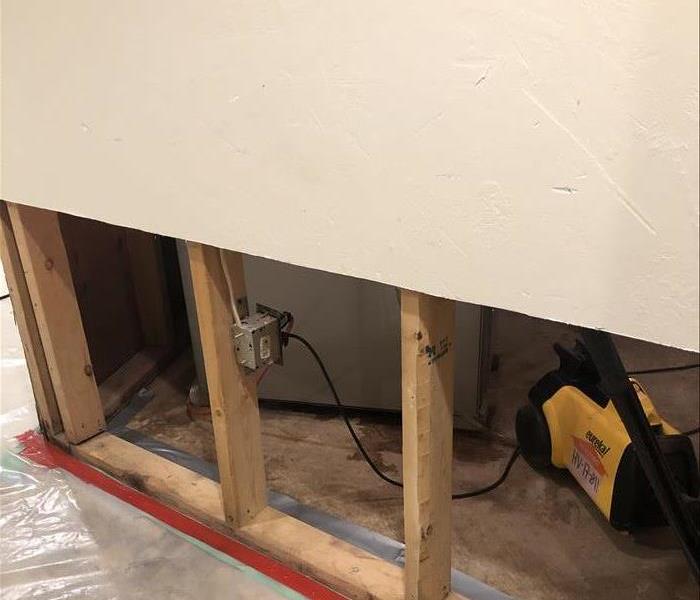 Pictured is an example of a drywall flood cut in a flooded basement
Pictured is an example of a drywall flood cut in a flooded basement
Did you know that making your water damage disaster “Like it never even happened,” is a two-step process? And that each process is billed separately? The first step is what we call “mitigation”. The second step is what we call “rebuild”.
MITIGATION
The first and most important step is mitigation. The definition of mitigation is: “the action of reducing the severity, seriousness, or painfulness of something”. In the water restoration industry mitigation is the actual drying of your structure in a timely manner, with timely being the key word.
Drying your structure in a timely manner after a water loss is essential to reducing its severity. Timely drying of your structure prevents something we call “secondary damage” and makes it more likely that we will be able to save versus having to remove parts of your structure. When things like wood, drywall, fabric, carpeting, insulation, and so much more get wet, they need to be dried quickly, to prevent the growth of mold and bacteria, wood rot, leaching, and delamination. (Delamination is a mode of failure where a material fractures into layers.) Once these things happen, very often there is no choice but to remove them.
Our goal in the mitigation process is to dry the structure while saving as much of it as we can with as little disruption as possible. That said, the drying process can require the removal of things like woodwork, cabinets, carpet padding, and more, in-order to get air circulating behind and under them.
Drywall is a perfect example. Our first choice is to completely dry drywall in place. In-order to do this, it is important to get air circulating behind the drywall. Drywall can often feel dry to the touch even though it is not. Things like paint can mask the moisture that is hidden on the back side of the drywall. If that happens, mold and bacteria will start to grow on the backside of the drywall and the building will begin to stink and maybe even become unhealthy. We have special meters that can detect moisture hidden deep within. If we detect moisture on the backside of your drywall our first choice will be to dry it in place. We do this by removing the baseboards, drilling holes in the drywall behind the baseboard and putting special low-profile air movers up to the holes to get air circulating behind the drywall. Once the drywall dries, the baseboard can be put back up. The baseboard will cover the holes and the water damage to the drywall will be "Like it never even happened.”
If, however the drywall is too saturated or has been wet for too long, it may need to be removed. But even then, we do it with as little disruption as possible. We only remove drywall that cannot be saved. When the water has come from the ground up like in a flooded basement situation, this often results in something we call a “flood cut”. This is where we cut and remove only the drywall at the bottom 1/3 of the wall or the drywall that cannot be saved.
The second step after mitigation is to “rebuild”, or put back, everything that has been displaced or completely removed in the mitigation process.
REBUILD
During the rebuild phase, things that were displaced or removed are put back or replaced. In our drywall example above, if we were able to dry the drywall in place, the rebuild phase would involve putting the baseboard back up and thereby covering the holes in the drywall. If any drywall could not be saved and had to be removed like in our flood cut example, new drywall is put up, taped, mudded and the wall painted.
It is important to note that these two steps are truly separate and distinct and are even billed separately. The mitigation process is the part that is most necessary. It prevents further damage and preserves the safety of the structure.
Some water restoration companies do not offer rebuild services. We are a full-service restoration company with in-house carpenters and regular subcontractors for all of our customer’s rebuild needs. Once the mitigation process is complete, we will ask you if you want a bid for the rebuild process. While some property owners choose not rebuild at all, do the work themselves, or have a different contractor they prefer to use for construction jobs, many end up doing the rebuild work with us. But much of it depends upon their level of insurance coverage and their own financial situation.
One of the most common problems we see is an inadequate amount of insurance coverage. Many property owners have adequate coverage to pay for the mitigation process, but they do not have enough to cover the rebuild process. If you want your water damage situation to truly be “Like it never even happened,” talk to your insurance agent today to make sure you have adequate coverage to cover both steps.
Proper Grading Around Your Home or Business
4/21/2020 (Permalink)
In a recent blog post we talked about flood water and the need for flood insurance. If your home falls in a high-risk flood area, you should talk to your lender or insurance agent about flood insurance today.
But sometimes even homes that aren't in a high risk area can experience flood water during particularly heavy rains, or in the spring when the ground is still frozen. Remember any water that flows over the ground and enters your home or basement through a window or any other crack or opening can be considered flood water.
Therefore it's essential that the ground around your foundation is properly pitched or slopped so that rain water flows away from your home and foundation.
Following is a great video from YouTube to show how the ground should be pitched around your home. Take some time this spring to check the grading around your home to prevent problems down the road.
https://www.youtube.com/watch?v=5hYIda7tWqA&fbclid=IwAR2kGCJfBaieaNHKx4o
Flooding & Flood Insurance
4/15/2020 (Permalink)
The spring rainy season is upon us. We have already begun receiving calls from home and business owners alike with flooded basements. But did you know that where the water comes from is an important factor in determining if your homeowner’s insurance policy will cover losses associated with water in your basement?
Most often, water that flows across the ground and enters your basement through a window, door, or any other crack or opening is considered “flood water”. According to Wikipedia, “Flooding is defined by the National Flood Insurance Program (NFIP) as a general and temporary condition of partial or complete inundation of two or more acres of normally dry land area or two or more properties (at least one of which is your property) from: Overflow of inland waters, unusual and rapid accumulation or runoff of surface water from any source…”
Losses associated with flood water are not generally covered by a standard homeowner’s insurance policy. To be covered for losses associated with flood water, homeowners must have specific flood insurance. Yet it is estimated that nationwide only about 20% of homes at risk for floods are covered by flood insurance. If you live near a body of water and don’t have flood insurance, talk to your lender or insurance agent about this very important coverage today.
Ice Dams
1/14/2020 (Permalink)
Ice dams can be a major problem during the winter season.
An ice dam is a ridge of ice that forms at the edge of a roof and prevents melting snow (water) from draining off the roof. Typically ice dams form slowly. As snow melts from your roof, either by the heat of the sun, or by heat escaping from your home, it tends to refreeze at the edges and other juncture points of your roof. The refreezing of water has a damming effect creating an even bigger ice dam behind it. Continuous feeding of the ice dam by melting and refreezing snow melt can cause significant damage. As the water seeps under shingles it refreezes expanding and creating an even bigger gap for future drainage to fill and further the cycle. Your shingles are being raised and eventually the water that backs up behind the dam, and underneath the shingles, can leak into your home and cause damage to walls, ceilings, insulation, and create a perfect environment for mold growth.
Last winter however an unusual storm dumped a couple of inches of snow/ice on our area. Homes that typically don't have problems with ice damming suddenly had ice dams overnight. As that ice began to melt several days later, these homes had water leaking in to their homes.
If you have water in your home this winter from ice damming, SERVPRO of Appleton & Winnebago County can help.
Why Emergency Ready Profiles are Helpful
10/11/2019 (Permalink)
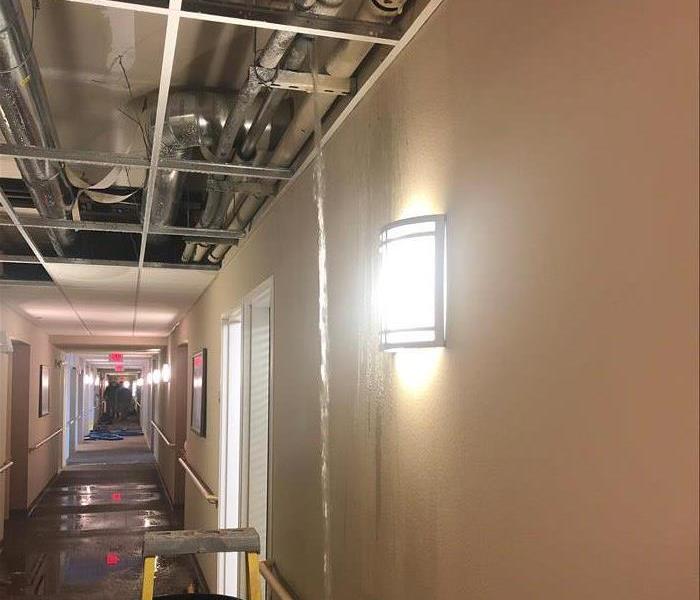 In this photo, the water has been shut off and a garbage can has been placed to collect water that remains in the pipes as it drains out.
In this photo, the water has been shut off and a garbage can has been placed to collect water that remains in the pipes as it drains out.
In our last blog post we talked about Emergency Ready Profiles. The attached photo demonstrates a situation where an Emergency Ready Profile is useful.
Yesterday we were called to a water loss at a Senior Living Community. A water main burst at both ends of a long hallway spraying water all over the place.
In a situation like that, it's important to know exactly where the water shut off valves are and get them shut off as quickly as possible. Once the water is off, the next step is to call the appropriate emergency contacts to get the pipe fixed and dry your structure.
An Emergency Ready Profile gives you all of these things in a convenient app on your phone, so that no matter where you are, or what time of the day it is, you are ready to respond.
In this situation, SERVPRO of Appleton was on the job quickly to begin drying the structure. It was a big task with 55 rooms being effected including tenant units, a community room, offices and more.
What to do Should You Experience Water Damage
5/29/2019 (Permalink)
Many years ago Linda Cobb appeared on the Oprah Winfrey Show. She spent 15 years as the owner of a disaster restoration company in Michigan and she is the author of a great book entitled “Talking Dirty with the Queen of Clean”. As the books back cover says it’s “a marvelous collection of miraculous cleaning tips and surprising shortcuts that get the job done quickly and well”. It addresses everything from how to get various types of stains out of laundry to cleaning your outdoor deck and everything in between. It has come in handy many times in our own home. And the advice she gives in Chapter 30 entitled “The Big Drip-Water Damage Restoration” is spot on.
“What a shock! When you left the house everything was fine.
You come home and unlock the door; you walk in and hear the sound of running water. As you step in, water comes up to your ankles. Now you find water running across the carpet and floors and lapping at the legs of furniture as the sofa and chairs try to soak it up. Here’s what you need to do immediately.
Turn It Off
First, know where your water shut-off is and use it. Turn off the water and look for the source of the leak. BE SURE THE ELECTRICAL POWER SOURCE IS OFF BEFORE YOU WALK IN STANDING WATER. The leak could be a toilet, the washing machine hoses, or a broken pipe.
How quickly you react will have impact on what can be saved in your home.
Call the Professionals”
And of course that’s where we come in. Our professionals at SERVPRO of Appleton are just the people to call in such an emergency. We help people in situations like this everyday.
Ice Dams & Water in Your Attic
3/28/2019 (Permalink)
In our January 23rd blog we talked about the possibility of roof ice dams this winter. In the blog we explained what ice dams are, and some things you can do to avoid them. And sure enough, we received many calls this past month from homeowners that experienced water damage to their home because of ice damming. In all of these cases, water was leaking, and in some cases running, into the living areas of the home.
But what if you had ice, ice dams, or icicles on your roof but didn’t see any water in living areas of your home? Is it safe to assume you didn’t experience any water damage? The answer is no. It is entirely possible that water leaked into your attic space but never made it to your living areas. And if that happened, you may have mold and eventually wood rot in your attic.
If you had ice damming on your roof this past winter, a thorough inspection of your roof to check for shingle damage, and a thorough inspection of your attic to check for water intrusion, is a good idea.
Ice Damming
1/23/2019 (Permalink)
The first major snow of the season has fallen. Soon you may see icicles hanging from the gutters of homes. But did you know that those icicles are most often the result of ice damming and can lead to water damage and eventually mold in your home?!
An ice dam is a ridge of ice that forms at the edge of a roof and prevents melting snow (water) from draining off the roof. As snow melts from your roof, either by the heat of the sun, or by heat escaping from your home, it tends to refreeze at the edges and other juncture points of your roof. The refreezing of water has a damming effect creating an even bigger ice dam behind it. Continuous feeding of the ice dam by melting and refreezing snow melt can cause significant damage. As the water seeps under shingles it refreezes expanding and creating an even bigger gap for future drainage to fill and further the cycle. Your shingles are being raised and eventually the water that backs up behind the dam, and underneath the shingles, can leak into your home and cause damage to walls, ceilings, insulation, and create a perfect environment for mold growth.
To prevent ice dams, it’s important to clean your gutters before winter so that winter’s melting snow and rain can properly drain off your roof.
Additionally, improper insulation and improper attic ventilation can contribute to ice damming by allowing warm air from inside your home to escape into the attic. It seems counter-intuitive, but the basic ventilation principal for your attic is to keep it as cool as possible during the cold season. If you look at your roof several days after a snow and you see an even distribution covering your roof, that’s a good sign that your attic is properly insulated and ventilated. If on the other hand, you see sections where snow has melted, that suggests an area in the attic where warm air is present due to either improper insulation or improper ventilation. These problems should be addressed as soon as the weather allows.
Some homeowners also find it useful to use a roof rake during the winter months. A roof rake is not your average garden rake. It is a specialty item used to remove snow from the 4-6 feet of roof above your gutter, while standing safely on the ground, so that melting snow can properly flow off of your roof versus forming an ice dam. Roof rakes can be found in season at most hardware and home improvement stores. If you choose to use a roof rake, it’s important to follow all suggested safety precautions and suggestions for use. Additionally, it’s important to know the condition of your roof and shingles. Older roofs, or roofs in poor shape, can easily be damaged by roof rakes and may cause more harm than good.
April Showers Bring...Water in Your Basement
4/16/2018 (Permalink)
While the old saying “April showers bring May flowers” may be true; April showers (and even April snow storms!) can also bring water in your basement.
This time of the year water in your basement typically comes from one of the following sources:
- Water leaks in from the outside through a basement window or other opening
- Water overflows from your sump pump crock as the result of failed sump pump
- Water seeps up through cracks in your concrete floor or foundation, again often as the result of a failed sump pump
- Your sewer system backs up into your basement
But did you know that a standard homeowner’s insurance policy will not provide coverage for water damage caused by any of these four sources?! However, coverage for three of the four can be easily and inexpensively added on to a standard homeowner’s policy in the form of what’s called an endorsement. When this type of endorsement is active, it provides coverage of property damage caused by water that has managed to back up into your home from pipes, sewer systems, drains, sump pumps, water-service, or any additional system that transfers fluids to and from your home.
Now is an excellent time to check with your homeowner’s insurance agent to ensure you have this very important coverage! And for more on sump pumps and how they work, see our blog post from February 1, 2018.
Sump Pump Failure & Homeowner's Insurance
2/2/2018 (Permalink)
Yesterday we talked about sump pumps; how they work and why they’re important. Now imagine the potential damage to your home should your sump pump stop working for any reason; whether it be due to a power failure during a spring storm, or the simple mechanical failure of the pump itself. Without a functioning pump to pump the water out of your sump crock, and up out of your home, the crock will overflow into your basement, soaking your carpet and drywall if your basement is finished, and possibly destroying furniture, important documents and anything else you may have stored in your basement. And depending upon things like the water table and soil conditions in your area, the elevation of your home, and the amount of time the pump is out of order, the amount of water can be significant, causing havoc even in an unfinished basement.
Many people may assume that their homeowner’s insurance will cover this type of damage. But did you know that in most cases, a standard homeowner’s insurance policy does not provide coverage for water damage caused by sump pump failure. However, this type of coverage can be very affordable and can easily be added on to your standard homeowner’s policy in the form of what’s called an endorsement. When this type of endorsement is active, it provides for coverage of property damage caused by water that has managed to back up and into your home from pipes, sewer systems, drains, sump pumps, water-service, or any additional system that transfers fluids to and from your home. Now is a perfect time of the year to check with your insurance agent to see if you have this important coverage, and if not, to add it before the heavy spring rains.
Sump Pumps: How They Work & Why They're Important
2/1/2018 (Permalink)
In our January 18th blog post entitled “Landscape Grading & Keeping your Basement Dry”, we talked about surface water runoff and the importance of keeping it flowing away from your home in-order to keep your basement dry. But did you know that water below ground can also be a threat to your foundation? That’s where your sump pump comes in.
In-order to understand how a sump pump works and why it’s important, it’s helpful to first understand the home building process. After a hole is dug by an excavator for a basement, the next step is to put in foundation footings. Foundation footings in Wisconsin are typically a poured cement slab, often reinforced with rebar. The footings are poured into the excavated trench essentially in an outline of the foundation walls. The footings provide a foundation upon which the cement bricks of the foundation will be laid, or upon which the cement walls of the foundation will be poured, depending on the type of basement wall construction used. The soil upon which these footings are poured needs to stay at a consistent moisture level to prevent settlement, heave, or differential movement. That’s where the sump pump and it’s supporting system comes into play.
A drain system is installed around the perimeter of the foundation/footings. This drain system is essentially a system of pipes (surrounded by crushed stone) with holes in the top that collect water that is heading towards the foundation walls. The water that is collected in these pipes is redirected into a sump crock in the basement, where a pump then pumps the water up and out of the basement. Proper installation and maintenance of this entire system is essential to keeping a basement dry and stable.
Flooding & Flood Insurance
1/30/2018 (Permalink)
Soon it will be that time of year when flooding will be all over the news. Did you know that a standard homeowner’s insurance policy does not cover damage from flooding? Water coming into your home or business from the outside, through a basement window or other opening due to excessive rain or rising bodies of lake, rivers, streams, etcetera, typically falls under the category of a flood, and most homeowner’s insurance policies do not cover floods. According to a 2016 poll conducted by the insurance information institute, only 12 percent of homeowner’s have flood insurance.
How can you protect yourself? The first step is to make sure that your yard is properly graded so that excessive rain, and any standing water resulting from excessive rain, flows away from, and not towards your house. For more information on this, see our January 18, 2018 blog posted titled “Landscape Grading & Keeping your Basement Dry”
The second step is to determine if your home is in a flood plain. If it is, you are at risk of flooding from rising bodies of nearby lakes, rivers, streams, etcetera. FEMA (Federal Emergency Management Agency) can provide you with information you need regarding flooding. They provide copies of the latest and most up-to-date flood zone maps for most communities. You can start by going to: https://msc.fema.gov/portal Here you will be able to type in the address of your property, hit “search” and then click on “view web map”. If you have any questions, or suspect that your property may be in a flood plain, talk to your insurance agent. You may be able to buy a separate flood policy through the federal government’s National Flood Insurance Program (NFIP). Talk to your insurance agent about this very important coverage and what your risks are. Not all areas of a flood plain have the same risk.
Having flood insurance, if it makes sense for your property, will allow you to get our experts in quickly to dry out your floors, walls, furniture and other belongings. When it comes to water damage, a fast response is important to keep costs down and prevent the growth of mold or other secondary damage.
Landscape Grading & Water in your Basement
1/18/2018 (Permalink)
It's hard to imagine right now, but spring will be here before you know it. And while spring may be a welcome sight for many of us, it isn't without it's problems. Many of you will find wet foundation walls or even water in your basement during the spring thaw. There are a couple of reasons why this might happen. One of them is something many of us never think about and that's the grading of our yards.
According to Wikipedia, "Grading in civil engineering and landscape architectural construction is the work of ensuring a level base, or one with a specified slope for a construction work such as a foundation, the base course for a road or railway, or landscape and garden improvements, or surface drainage."
It is important that the ground around your home slopes away from your foundation so that water, or surface drainage, from heavy rains or melting snow, runs away from your foundation and your home. Ground that is flat or slopes toward your foundation is a recipe for wet basement walls or water in your basement.
Proper slope and surface drainage is something that should be checked periodically. Ground shifts and settles with freezing and thawing, erosion and other impacts of nature. Settling ground is particularly pronounced in newer homes where the ground has recently been disturbed to build the home. The ground will compress or settle downward. Evidence of this will be more visually apparent in sinking walk ways or patios, but may not be as obvious in the ground around the foundation of the home as it is often hidden by shrubs and plants in landscape beds. It's important to check for proper slope every year or so and fill in with dirt if necessary to help keep your foundation walls and basement dry.
What is the proper slope away from your foundation? The consensus seems to be 6 inches for the first 10 feet extending out from your foundation. This translates to a slope of 5%. According to the Spruce,
"To find the slope away from your foundation, you will need:
- Some string (at least 12 feet long)
- 2 stakes (we will call them "A" and "B"), and something to pound them into the ground
- A string level (that is, a type of level designed to fit on a piece of string)
- A tape measure
Do You Already Have the Correct Slope?
Using the above supplies, take the following steps to determine if sufficient slope currently exists:
- Tie one end of the string loosely around stake A.
- Pound stake A into the ground right near your foundation
- Slide the string down stake A, so that it rests at ground level
- Tie the other end of the string loosely around stake B.
- Now measure out 10 feet down the slope from stake A, and pound stake B into the ground there (if there is excess string, just wrap it around stake B). The string between the stakes should be fairly taut, but still adjustable.
- Slide the string up or down stake B, so as to make it roughly level.
- Put the string level on the string, at about the mid-point between the stakes.
- Now adjust the string up or down on stake B, so as to make it exactly level.
- Measure the distance from the string on stake B to the ground. Is the measurement 6 inches or more?"
And if you do find yourself with wet foundation walls or a wet basement, SERVPRO of Appleton is always here to help.
Hot Water Heater Leaks
1/16/2018 (Permalink)
Most of us rarely think about our hot water heaters until they either fail to give us hot water or they leak all over our basement and cause significant damage. But in fact, due to the nature of what they due, water heaters are prone to leaks and often cause significant damage to your basement, especially if your basement is finished. It's a much harder clean up if you have wet carpeting and drywall versus cement floor and walls.
Hot water heaters operate by bringing cold water into the tank at the bottom. This water is then heated using natural gas, propane, fuel oil or electricity. The hot water then rises to the top where it is released to wherever warm water is needed in your home, while more cold water comes back into the tank to replace it, and the cycle continues. This process results in various spots where water can leak.
- Whenever you have a plumbing connection or plumbing lines, you have the potential for a leak and there are several near your water heater
- Because water is being heated, water heaters have a temperature & pressure relief valve. These valves can be faulty and cause a leak, or they can leak due to excessive pressure, overheating, or becoming stuck
- Your water heater has a drain valve. This drain valve can fail to close completely and can cause leak.
- If you have an electric water heater, leaks can occur due to a loose heating element or a bad gasket
- The tank itself can corrode and water can leak out the bottom
To protect yourself from significant water damage from a leaky hot water heater, you can install an automatic water shut off valve. Moisture sensors are placed on the floor near or under the water heater. If a leak is detected, the sensors send a signal to the control box which in turn closes the valve, shutting off the water supply.
Frozen Water Pipes
1/8/2018 (Permalink)
Much of the country recently experienced a severe cold snap. And as temperatures began to rise this past weekend, we at SERVPRO were inundated with calls to clean up water damage at both commercial and residential properties due to burst water pipes. It may seem counter intuitive. The temperatures are rising, so why are pipes bursting now?
Without getting into the chemistry of water and what causes it, suffice it to say that water expands as it freezes. While this expansion can cause a weak pipe to burst, it's usually not the direct cause of a burst pipe. Pipes usually burst where little or no ice has formed. That's because the break is usually the result of increased pressure in the pipe and not expanding ice. Pipes burst when water thaws and begins to flow, but then runs into other, still-frozen parts of the pipe and builds up pressure.
What can you do to prevent burst pipes? The simple and most direct answer is to keep your water pipes warm and prevent them from freezing. Typically homes in Wisconsin are built with the water pipes located on the inside of the building insulation, which protects the pipes from subfreezing weather. That said, if your homes insulation is inadequate, you may have a problem. Also consider that any hole on an outside wall for things like television or cable wires, phone wires, or even furnace exhaust vents, can let cold air in. These openings need to be properly insulated as well. If you're building a new home, or doing a home remodel project, it's also a good idea to locate your plumbing pipes on inside walls versus outside walls whenever possible.
To further protect your water pipes, it's a good idea to insulate the pipes themselves. Most hardware stores or home improvement stores carry foam rubber or fiberglass sleeves that most homeowners can install themselves. Plumbing supply stores and insulation dealers carry pipe sleeves that feature extra-thick insulation, as much as one or two inches thick. These sleeves will obviously cost a little more but may be worth the extra cost.
One last thing to consider. The best insulation in your home, and on your pipes, may not be enough to protect your pipes from freezing during a particularly cold spell like the one we recently had, if your furnace goes out while you are out of town on vacation. If you plan to be out of town during the winter months, you may want to consider purchasing a remote temperature monitor. A remote temperature monitor is a digital thermometer that tracks ambient changes in temperature. The sensor then streams the temperature data using wireless technology such as Wi-Fi, Bluetooth or GSM to your computer, tablet or cell phone. This way you can be alerted to any problems at home, even when you're away, so that you can send someone to address the problem before it's too late. Remote temperature monitors are not terribly expensive. They can be purchased on-line or at hardware stores and home improvement stores for as little as $50 or less.
And as always, if one of your water pipes bursts and floods your home or business, the experts at SERVPRO of Appleton are here to help.
Flooded Basement after Heavy Rain
4/26/2017 (Permalink)
The spring and summer rainy season is upon us and you may find yourself with water in your basement.
The first question many homeowners ask is “Will my homeowner’s insurance cover the cost of this mess being cleaned up and dried out by SERVPRO?” Only your insurance agent and/or adjustor can say for certain whether a claim will be covered. But here are some guidelines to consider in such situations.
The source of the water is a major factor. The most common sources of water in your basement following heavy rains include the following:
- Water leaks in from the outside through a basement window or other opening
- Water overflows from your sump pump crock as the result of a failed sump pump
- Water seeps up from cracks in your concrete floor or foundation as the result of a failed sump pump
- Your sewer system backs up into your basement
Water coming in from the outside through a basement window or other opening due to excessive rain or rising bodies of lakes, rivers, streams, etc, typically falls under the category of a flood, and most homeowner’s insurance policies do not cover floods. According to a 2016 poll conducted by the Insurance Information Institute, only 12 percent of homeowner’s have flood insurance. To get flood coverage, you may be able to buy a separate flood policy through the federal government’s National Flood Insurance Program (NFIP). Your local insurance agent can help you determine if such a policy makes sense for you, and can help you purchase this type of policy.
But what if the water came from your sewer system or a failed sump pump? In most cases, a standard homeowner’s insurance policy does not provide coverage for water damage caused by sump pump failure. However, this type of coverage can be very affordable and can easily be added on to your standard homeowner’s policy in the form of what’s called an endorsement. When this type of endorsement is active, it provides for coverage of property damage caused by water that has managed to back up and into your home from pipes, sewer systems, drains, sump pumps, water-service, or any additional system that transfers fluids to and from your home.
The spring rainy season is a perfect time to check with your insurance agent to ensure that you have this very important coverage. So that if disaster strikes, SERVPRO of Appleton can make it "Like it never even happened."



 24/7 Emergency Service
24/7 Emergency Service
